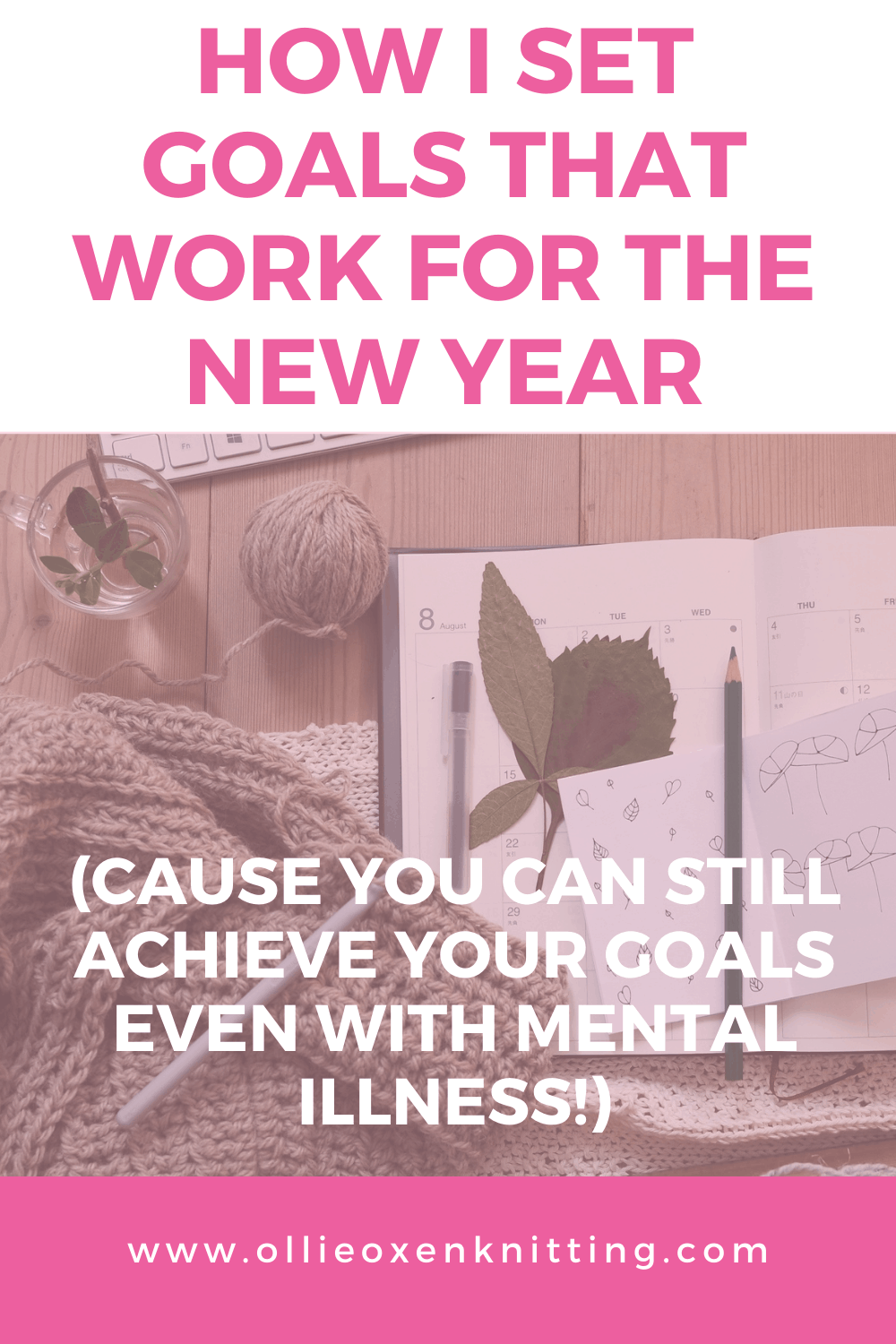I’m pretty excited today and you wanna know why? Cause I just got my new planner! I absolutely love setting it up for a new year! I know some people are more about their digital planners and that’s cool but I’m in love with my paper planner and I don’t care who knows it!
I’m not exaggerating when I say that my planner keeps me sane. While my mental health care plan has many pieces, keeping up with the goals in my planner is one of the best things I’ve found to keep me mentally steady. So yeah, getting a new planner is a pretty exciting time for me!
One of the hands down best parts of a planner for me is getting to fill it up with new goals. For me, a goal=a dream. And who doesn’t love dreams? When I set up my goals, I’m very intentional about making them achievable no matter what is happening with my mental state. The way I set up my goals for the year is a little different than most but if you’re new to making plans or just wanna know how I do it, let’s get planning!
Who Is This Right For?
Like I said, the way I set up my goals is tiny bit different than the typical way. I get sick a LOT so I have to keep that in mind when I’m creating my goals. I struggled for a long time to find a method that gave me the structure and progress I craved while giving me the grace and rest I needed. So far, this method seems to be just the ticket!
It’s not good for…
But if you’re a person…
This could be the method for you! As with anything in life, what works for you may look different than what works for me but the most important thing is that it works for YOU. Now let’s hop into setting some goals!
Step One: Dream!
To start, you’re going to essentially brain dump everything, and I mean EVERYTHING, you want to do over the next twelve months. Really go crazy with it! Right now, practicality doesn’t matter. Just write it all down. I especially love to use pretty markers and pens at this stage to really pump it up.
Some things to think about:
Who would you like to be in one year? What feathers do you want to add to your hat? Keep in mind that I’m sure you’ll do much more than what is on your paper. Life has a way of helping us to always grow and stretch. But what do you want to be intentional about developing? Add it to your paper and dream big!
Step Two: Compare to Life Long Goals
Wasn’t that fun? Now we’re going to start crossing off ones that don’t line up with what is truly important to you. By removing goals that don’t line up with your big life goals, it helps prevent you from falling away part way through the year. It’s not that you can’t do these things; it’s just that they won’t be taking center stage.
For example, one of the things I crossed off was “sew a winter coat”. While yes, I can sew a bit, the amount of effort it would take to get good enough to sew a winter coat is just not something I honestly have the emotional resources to accomplish. It doesn’t line up with any of my life long goals and I have other things that I’d like to do in the mean time. To someone else, that goal may be perfect. But for me, it’s just not a great fit right now. Don’t be afraid to cross things off. Like my dad always said, “I’m not telling you ‘no’; I’m telling you ‘not now'”.
Step Three: Organize Goals Into Categories
Next we’re going to sort our goals into categories. This helps make it easier to have a well rounded life. I like to have my goals spread out pretty evenly but your mileage may vary!
I color code my life so it’s quick and easy to see how my stuff is lining up. Just circle each goal with the corresponding color and I have a quick visual of how things are shaking up.
My categories are:
Personally, I try to have two to three goals in each of these categories. I feel like it helps make my life more well rounded. My goals are also drastically different for each category so, despite what illness I may be feeling, I’m normally able to make headway with at least one of my goals at all times.
When you look at your goals, do you feel like they are well rounded for your life? For example, there was a time where my physical health was no bueno but I felt secure in my relationships. That year, I had more goals in the physical category and more of maintenance goals for family and friends. That year, that was well rounded for me. What does your list look like? Make adjustments as needed.
Step Four: Convert Into SMART Goals
The next step is to make sure each of our goals is a “SMART goal”.
SMART stands for:
SMART goals are hands down the best way to make sure you’re setting your goals up for success. It’s important that your goal check off all five of those marks.
Here’s an example of goals that aren’t all that SMART vs one that is:

When it comes to basing goals off of time, I like to base all of my plans off of 10 months. Like I said, I get sick a lot and when you add in holidays, birthdays and unexpected things, this is a number that seems to do ok for me. So, essentially, if I have a big goal, I break it down into ten equal parts. November and December are bonus months for me. By dividing the goal, I now have my monthly goal. Depending on the goal, I’ll divide it into smaller chunks to give myself weekly or daily goals. Pretty neat, hu?
Step Five: Create a Plan
This step has been a pivotal part of my goal setting process. What we’re going to do is come up with a plan for exactly what you’ll do to get your goal accomplished. Sure, your goal may sound simple right here and now, but if you’re anything like me, when that illness strikes, even just thinking can feel so daunting.
This is our way around that. Personally, I find this step comforting. I feel like it’s my way of taking care of future me. Future me can do whatever she wants but I’m making her job easier by giving her information just in case.
Create a pathway so that you don’t really have to think about it. I like to add in a little wiggle room so that I have more a few extra ways to get my goals accomplished. Plan for success!
Step Six: Create Mini Goals
You’re almost done! The next step is to create mini versions of all of your goals. This is a step not many people seem to do but I feel like it’s absolutely essential for people with varying degrees of physical and mental energy.
Essentially, you want to create goals so tiny you can easily do them no problem each and every day. While they may not seem like much in the moment, the compound effect can be incredible.
Here are some examples of mine this year:
See how small they are? Even on a day where I’m sick, I’ll most likely still be able to do some of those. This way even if I’m not feeling my best, I’ll still be able to chip a little away at my big goal. This, my friends, has been one of my big secrets to success.
Step Seven: Fill in Your Planner And Set Up Accountability
This is the part that gets me super excited: filling in your planner! I use a Happy Life planner but you do you! I just love getting all my stickers and pens out and watching the new year unfold before my eyes.
After I’ve added holidays and birthdays to my planner, I start adding in my goals. For things that are kind of “one and done” I add it to the monthly overview page. For the goals that require more checking in, I write them on the weekly pages. Different goals make sense in different ways but I find that a variety helps the most.
One thing I don’t do is write down goals on specific days. Because I never know when I’ll be having an off day, I keep things on a weekly level. That allows me to check things off as I’m able while keeping my goals at the forefront of my mind.
Now it’s time to make sure that our goals don’t fall by the wayside. I do this in two main ways.
First, I find a few accountability buddies. I’ll encourage them with their goals if they’ll help encourage me with mine. Secondly, I add reminders to my planner. During the first week of each month, I write down “review goals” in my to-do list. I also create pages for my planner specifically for reviewing my goals. These have me evaluate what is and isn’t working. I like to add them every three months so that, even if I do backslide a little, I can get jolted back into action.
Bonus! Set Up a Success Routine
By grouping together your mini goals into a routine, you can get a lot done in a small amount of time. How can you get as many of your mini goals done at once? Is there anyway you can batch some of them together throughout your day?
I like to have two success routines; one in the morning, and one in the afternoon. This way, even if I’m sick during one of the routines, I’m less likely to miss the other. Doing this dramatically increases my ability to work on my goals when I’m mentally or physically ill. Play around with it and find what works for you!
For me I can:
In about ten minutes, I’ll have made steady progress on seven of my goals. I don’t know about you but I think that’s pretty amazing! By keeping all of the needed items at my desk, I can make some big strides with minimal effort. Remember: big strokes fell great oaks!
What About You?
How do you set up your goals? Let us know in the comment section down below!












